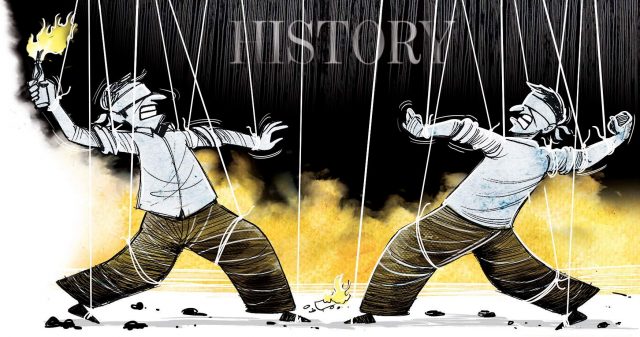
The violence and social tensions that gripped large parts of Maharashtra and hit headlines for days together, can be traced back to the British conspiracy of exploiting the fault lines in the Indian society to serve their imperial ends. Surprisingly a section of Indians still continues to wallow in that divisive mindset, 70 years after the departure of the British.
Intra-faith violence was common in medieval Europe, and still claims hundreds of lives in the Islamic world which is riven with intermittent Shia-Sunni conflicts. Wars between Protestants and Catholics had resulted in thousands of deaths in the West between the 15th and 18th century.
In the case of India, two facts stand out. One, for centuries, caste Hindus subjected a section of their own faith to inhuman treatment and humiliation. Two, starting with Guru Nanak, the enlightened spiritual and political leadership of the Hindus has been relentlessly fighting against this injustice. Thanks to the efforts of Hindu social reformers, none today defends untouchability on an intellectual level, though traces of social prejudices still survive. It is against this background that reservations for Dalits became possible.
The Constituent Assembly was dominated by caste Hindus. They agreed to reservations in an effort to undo the historical injustice done to the Dalits. The reservations, which were supposed to be in place for 10 years, got extended many times. Every constitutional amendment for extending reservations had unanimous support of Parliament, irrespective of the party in power.
The recent flare-up can easily be attributed to what has aptly been described as ‘Break India Gang’. Its declared objective is to Balkanise India. Dalits, in their scheme of things, are fodder to fuel their divisive agenda. A false binary—Dalits versus rest of the Hindu society— has been sought to be built on the basis of twisted facts and falsified history. And efforts are being made to create an alliance between Muslims and Dalits, an idea which has been repeatedly tried earlier, but without much success.
So what is the history of 200-year-old Koregaon battle between the invading East India Company and Maratha forces? On 1 January 1818, the Company forces and Marathas fought at Koregaon. The British Army consisted of people from various communities, not just the Mahars. Similarly, the Peshwa Infantry too had soldiers from many communities including from low castes. How does it then becomes a Mahar against Peshwa battle instead of a British versus Indians battle? Stretch this sick logic further. Who was responsible for Jallianwala Bagh massacre in 1919? Was it General Dyer who ordered the firing or the 50-odd Gorkha soldiers under his command who pulled the trigger?
What was the status of Mahars prior to the arrival of the British? The Mahars, known for their hard work and fighting capabilities, were recruited by Shivaji and his successor Sambhaji as scouts and fort guards. The mutilated remains of Sambhaji, after he was executed by Aurangzeb were cremated by Ganesh Mahar.
In fact the British were more afflicted with caste bias than the much-abused Peshwas. In 1892, motivated by the infamous ‘martial race’ theory, the British decided to institute “class regiments” and Mahars were not considered good enough to be included in the army. However, during World War I, the British allowed the recruitment of the Mahars in the army but immediately after the War, excluded them.
In 1927, Babasaheb Ambedkar made attempts to make the British recruit the Mahars once again and he was supported by Veer Savarkar. Savarkar was invited and presided over the Mahar conference at Ratnagiri. Another prominent Hindu Mahasabha leader close to Ambedkar who fought against the pseudo-scientific martial races theory was Dr Moonje. In his presentation on the Indianisation of the army to the Chetwode Committee in 1931, Moonje criticised the martial race policies as “the myth of the artificial distinction of martial and non-martial classes”.
Dr Ambedkar, in his last speech on 25 November 1949 in the Constituent Assembly said, “What perturbs me greatly is the fact that not only India has once before lost her independence, but she lost it by the infidelity and treachery of some of her own people. In the invasion of Sind by Mahommed Bin Kasim, the military commanders of King Dahar accepted bribes from the agents of Kasim and refused to fight on the side of their king.
When Shivaji was fighting for the liberation of Hindus, the other Maratha noblemen and the Rajput kings were fighting the battle on the side of Moghul Emperors. When the British were trying to destroy the Sikh Rulers, Gulab Singh, their principal commander sat silent and did not help to save the Sikh Kingdom.
In 1857, when a large part of India had declared a war of independence against the British, the Sikhs stood and watched the event as silent spectators. Will history repeat itself? It is this thought which fills me with anxiety. This anxiety is deepened by the realisation of the fact that in addition to our old enemies in the form of castes and creeds we are going to have many political parties with diverse and opposing political creeds.
Will Indians place the country above their creed or will they place creed above country? I do not know. But this much is certain that if the parties place creed above country, our Independence will be put in jeopardy a second time and probably be lost forever. This eventuality we must all resolutely guard against. We must be determined to defend our independence with the last drop of our blood.”
Will those playing havoc with the country in Ambedkar’s name answer?
By Balbir Punj
Former Rajya Sabha member and Delhi-based commentator on social and political issues
Email: [email protected]
Courtesy: The New Indian Express














